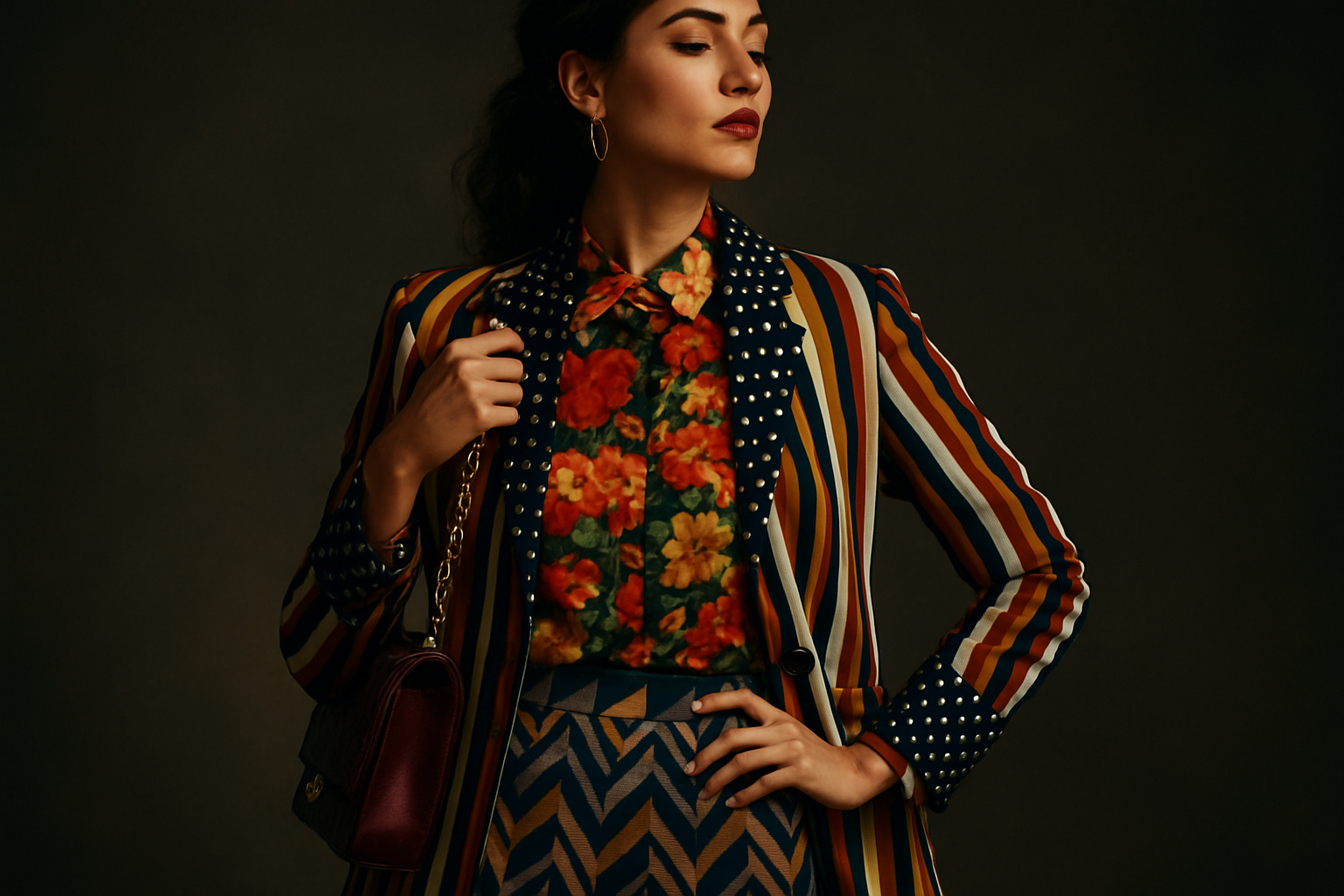The Sartorial Symphony: Orchestrating Patterns in Fashion
Fashion's latest crescendo is resonating through the world of patterns, harmonizing bold prints with subtle textures to create a visual masterpiece. As style enthusiasts seek to express their individuality, the art of pattern mixing has emerged as a powerful tool in the fashionista's arsenal. This trend isn't just about clashing prints; it's about composing a sartorial symphony that speaks volumes about personal style and creative flair.

In recent years, designers have been drawing inspiration from diverse sources, from traditional African wax prints to digital glitch art. This fusion of old and new, global and local, has created a rich tapestry of possibilities for the modern wardrobe. The evolution of pattern mixing reflects a broader shift in fashion towards individuality and self-expression, challenging the notion that patterns should be worn in isolation.
Composing Your Look: The Art of Pattern Harmony
The key to successful pattern mixing lies in understanding the principles of visual harmony. Just as a skilled conductor balances different instruments in an orchestra, a fashion-forward individual must learn to balance various patterns in an outfit. The goal is to create a look that’s both cohesive and intriguing.
One approach is to start with a dominant pattern and then introduce complementary or contrasting patterns in smaller doses. For example, a bold floral blazer can be paired with a subtly striped shirt and a polka dot pocket square. The trick is to vary the scale of the patterns – mixing large prints with smaller ones creates depth and prevents the eye from becoming overwhelmed.
Color also plays a crucial role in pattern mixing. Sticking to a consistent color palette can help tie disparate patterns together. Alternatively, using patterns in different shades of the same color family can create a sophisticated, tonal look that’s both daring and refined.
The Pattern Palette: From Classic Motifs to Digital Prints
Today’s pattern mixing trend embraces an eclectic range of motifs. Traditional patterns like stripes, checks, and polka dots are being reinvented and combined in fresh ways. Meanwhile, digital printing technologies have opened up a world of possibilities, allowing for photorealistic prints, abstract designs, and even interactive patterns that change with movement or temperature.
Geometric patterns are having a moment, with designers exploring everything from simple grids to complex tessellations. These structured designs often pair well with more organic patterns like florals or animal prints, creating an intriguing juxtaposition of natural and man-made elements.
Texture is also being incorporated as a form of pattern. Embossed fabrics, jacquards, and three-dimensional embellishments add another layer of complexity to pattern mixing, inviting not just visual but tactile exploration.
Breaking the Rules: The New Pattern Paradigm
While there are guidelines for pattern mixing, the current trend encourages breaking traditional rules. The fashion-forward are pairing patterns that were once considered clashing, such as stripes with checks or multiple florals in different scales. This rebellious approach reflects a broader shift in fashion towards individuality and self-expression.
However, successful rule-breaking requires a keen eye and confidence. It’s about understanding the rules well enough to know how to bend them effectively. This might mean mixing patterns within the same family – like pairing a pinstripe suit with a wider striped shirt – or combining patterns from different style eras, such as a 70s-inspired geometric print with a contemporary digital design.
Patterns in Practice: From Runway to Everyday
Translating runway pattern mixing into everyday wear can be daunting, but it’s all about starting small and building confidence. Begin by introducing pattern mixing through accessories – a patterned scarf with a printed blouse, or mixing patterns in your socks and tie. As you become more comfortable, you can experiment with bolder combinations.
Layering is another effective way to incorporate pattern mixing into your wardrobe. A patterned cardigan over a dress in a different print can create a pulled-together look that’s both playful and sophisticated. Don’t be afraid to mix patterns across different garment types – a floral skirt can look stunning with a striped top, especially when tied together with solid-colored accessories.
Mastering the Mix: Expert Tips for Pattern Play
-
Start with a neutral base: A solid-colored item can anchor your look and prevent pattern overload.
-
Mind the scale: Combine large-scale patterns with smaller ones for visual balance.
-
Stick to a color theme: Unify different patterns by keeping them in the same color family.
-
Use stripes as a neutral: Thin stripes can act as a versatile base for bolder patterns.
-
Don’t forget texture: Incorporate textured fabrics as a subtle way to add pattern.
-
Balance busy with calm: Pair complex patterns with simpler ones to avoid visual chaos.
-
Experiment with monochrome: Try mixing different patterns all in black and white for a chic, cohesive look.
As we orchestrate our wardrobes with an ever-expanding palette of patterns, we’re not just following a trend – we’re composing personal style statements. Pattern mixing invites us to be bold, creative, and uniquely ourselves. By understanding the principles of harmony and contrast, we can create outfits that sing with personality and flair. So go ahead, conduct your own sartorial symphony – the fashion world is your stage, and patterns are your instruments of self-expression.





